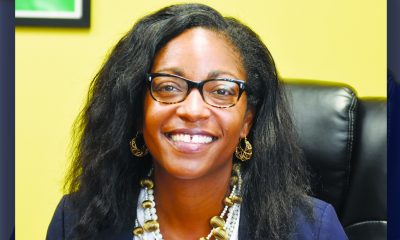Advice
Smart Financial Moves for Every Stage of Life
PASADENA JOURNAL — Regardless of what stage of life you’re in, you must make financial and investment decisions that will be with you for the remainder of your years. But the moves you make when you’re just starting out in your career may be quite different from when you’re retired. So, let’s look at some of these moves, stretched out across your lifetime.
Regardless of what stage of life you’re in, you must make financial and investment decisions that will be with you for the remainder of your years. But the moves you make when you’re just starting out in your career may be quite different from when you’re retired. So, let’s look at some of these moves, stretched out across your lifetime.

Arnetta Tolley
- In your 20s and 30s: During this period, you should strive to place yourself on a sound financial footing by taking steps such as reducing, and hopefully eliminating, your student loans and embarking on saving for retirement through investments such as a 401(k) and IRA. You also might buy a home, which offers some financial benefits, but be careful not to become “house poor” by devoting too much of your monthly income to mortgage payments. If you have young children, you might also want to start saving for college, possibly through a 529 plan, which offers tax benefits, high contribution limits and the ability to switch beneficiaries, as needed. And if you do have a family, you’ll certainly need to maintain adequate life insurance. Also, since you’re at the early stages of your working life, you should chart a long-term financial and investment strategy with the help of a financial professional. Your strategy should encompass your important goals, risk tolerance and time horizon. And you’ll want to revisit your strategy regularly to accommodate changes in your life and financial situation.
- In your 40s and 50s: These are the years in which your career advances, leading to bigger salaries. The more you earn, the more you should be putting away in your 401(k) or other employer-sponsored retirement plan, along with your IRA. During the middle-to-end of this particular period, you might fi nish helping pay for your child’s higher education – which should free up even more money to put away for retirement. You also may want to consider long-term care insurance, which can help protect you against the devastating costs of an extended stay in a nursing home.
- In your 60s, 70s … and beyond: Once you’re in this age range, chances are pretty good that you’ll either retire soon or are already retired. (Although, of course, you may well want to work part-time or do some consulting.) However, you certainly haven’t “retired” the need to make financial and investment decisions, because you’ll have plenty, including these: When should I take Social Security? Will my investment portfolio provide me with enough income to help keep me ahead of inflation? How much can I afford to withdraw each year from my retirement accounts without outliving my resources? Again, a financial professional can help you deal with these and other issues.
Also, if you haven’t done so, now is the time to draw up your estate plans, so you can leave the type of legacy you desire – one that provides for the next generation (or two) and the charitable organizations you support. You’ll need to work with a legal professional to create estate planning documents and arrangements appropriate for your needs.
You will spend a lifetime making financial and investment decisions – so put in the time and effort, and get the help you need, to make the best decisions you can.
[Arnetta Tolley, Financial Advisor, Edward Jones 626-744-2740 or arnetta.tolley@edwardjones.com.]
This article originally appeared in the Pasadena Journal.
Activism
The Best Advice for Raising Children: Discipline That Makes Sense
In his book Developing Positive Self Images and Discipline in Black Children, Dr. Jawanza Kunjufu suggests that primary aims for socializing Black children should be: establishing goals related to God and the church; familiarizing children with religious texts like the Bible or Quran; educating them of Black culture like Khemetic (Egyptian) Civilization; enlightening them about Black leaders like Malcolm X and Sojourner Truth; and teaching them to strive to be employers, not employees.

By William A. Thomas, Ph.D.
In many African societies, the primary aim of socialization is to raise children to be socially responsible and eventually provide economic support to their parents and extended families. Ghanaian philosopher Kwame Gyekye taught that children are raised to be respectful of the wishes of their parents and extended adult family members.
In his book Developing Positive Self Images and Discipline in Black Children, Dr. Jawanza Kunjufu suggests that primary aims for socializing Black children should be: establishing goals related to God and the church; familiarizing children with religious texts like the Bible or Quran; educating them of Black culture like Khemetic (Egyptian) Civilization; enlightening them about Black leaders like Malcolm X and Sojourner Truth; and teaching them to strive to be employers, not employees.
Effective disciplinary strategies appropriate to a child’s age and development teach them to regulate their behavior; keep them from harm; enhance their cognitive, social, and emotional executive functioning skills; and reinforce the behavioral patterns taught by their parents and caregivers.
Below are some specific guidelines for disciplining children.
Listen to what children are talking about with interest and show them you understand their feelings. Remember, children mirror and learn about their emotional selves by hearing their feelings reflected back to them. Staying on target also means avoiding labels. When children fail to do what is expected, discussing it is helpful rather than saying how stubborn, lazy, dumb, or bad they are. By the same token, more positive labels can be helpful.
Dependability is another essential component of the discipline process. When parents are dependable, their children learn what to expect and are helped to feel secure. When parents are consistent, children learn to trust, that is, predict their parents’ behaviors with certainty. A child thinks, “When I spill something, I will always be asked to wipe it up.” A child thinks, “If I use foul language, I will always be corrected.” A child thinks, “If I take something that doesn’t belong to me, I will always have to give it back.” The ability to predict with certainty leads children to rely on their parents and the village/community in which they live. Children feel safe when they know what to expect.
Conclusions
It takes a village/community to raise the divine gift that is the Black child. Parents look to therapists for guidance concerning a variety of parenting issues, including discipline. Keep in mind that evidence suggests that corporal punishment is both ineffective in the long term and associated with cognitive and mental health disorders. When parents want guidance about the use of spanking, a child therapist can explore parental feelings, help them better define the goals of discipline, and offer specific behavior management strategies. In addition to providing appropriate education to families, the Bay Area Association of Black Psychologists (Bay ABPsi) can refer them to community resources, like parenting groups and classes.
About the Author
Dr. Thomas is a licensed clinical psychologist with a private practice in the SF/Oakland Bay Area and Beaumont. He is a member of Bay ABPsi, a healing resource committed to providing the Post Newspaper readership with monthly discussions about critical issues in Black Mental Health. Readers are welcome to join us at our monthly chapter meetings every 3rd Saturday via Zoom and contact us at bayareaabpsi@gmail.com.
Activism
AI Is Reshaping Black Healthcare: Promise, Peril, and the Push for Improved Results in California
Black Californians experience some of the worst health outcomes in the state due to systemic inequities, limited healthcare access, and exclusion from medical research. 16.7% of Black adults report fair or poor health, versus 11.5% of Whites. Black adults have the highest death rates from prostate, breast, colorectal, and lung cancer. Statewide, diabetes affects 13.6% of Black adults versus 9.1% of Whites, and 27% of Black adults over 65 have heart disease, compared to 22% of Whites. Life expectancy for Black Californians is about five years shorter than the state average.

Joe W. Bowers Jr.
California Black Media
Artificial intelligence (AI) is changing how Californians receive medical care – diagnosing diseases, predicting patient needs, streamlining treatments, and even generating medical notes for doctors.
While AI holds promise, it also poses risks, particularly for Black patients. It can provide faster diagnoses and expand access to care, but it may also misdiagnose conditions, delay treatment, or overlook patient’s critical needs. AI’s impact on Black patients depends on how biases in medical data and algorithms are addressed in its development.
“As we progress toward a society with increased use of AI technology, it is critical that the biases and stereotypes that Black Americans have faced are not perpetuated in our future innovations,” said Dr. Akilah Weber Pierson (D – San Diego), a physician and state senator spearheading legislative efforts to address AI bias in healthcare.
Why AI Matters for Black Californians
Black Californians experience some of the worst health outcomes in the state due to systemic inequities, limited healthcare access, and exclusion from medical research. 16.7% of Black adults report fair or poor health, versus 11.5% of Whites. Black adults have the highest death rates from prostate, breast, colorectal, and lung cancer. Statewide, diabetes affects 13.6% of Black adults versus 9.1% of Whites, and 27% of Black adults over 65 have heart disease, compared to 22% of Whites. Life expectancy for Black Californians is about five years shorter than the state average.
Benefits and Risks of AI in Healthcare
AI processes vast amounts of medical data using computer algorithms designed to identify patient health patterns, helping doctors to diagnose diseases, recommend treatment, and increase patient care efficiency. By analyzing scans, lab results, and patient history, AI can detect diseases
earlier, giving it the potential to improve care for Black patients, who face higher risks of prostate cancer, diabetes, heart disease and hypertension.
Dr. Judy Gichoya, an Interventional radiologist at the Emory University Winship Cancer Institute and AI researcher at Emory’s Healthcare AI Innovation and Translational Informatics (HITI) Lab, sees AI as a tool with great potential but cautions that its effectiveness depends on the diversity of the data it is trained on. She says, “Without diverse datasets, AI could overlook critical signs of diseases, especially in underrepresented populations like Black patients.”
Dr. Timnit Gebru, a computer scientist and AI ethics expert, is the founder and Executive Director of DAIR (Distributed AI Research Institute) in Oakland. She has extensively studied bias in AI systems and their impact on marginalized groups.
Gebru acknowledges that AI has the potential to improve healthcare by enhancing efficiency and expanding access to medical resources. But, like Gichoya she strongly stresses that for AI to be effective and equitable it needs to be subject to rigorous oversight.
AI is already helping doctors personalize cancer treatment by identifying biomarkers and genetic mutations. UCSF and Stanford Health use AI to analyze tumor DNA to match patients with the most effective chemotherapy or immunotherapy.
In diabetes care, AI predicts blood sugar fluctuations, helping doctors adjust treatment. It helps radiologists in early disease detection and identifies sepsis sooner, reducing hospital deaths. In cardiology, AI detects early signs of heart disease, spotting plaque buildup or abnormal heart rhythms before symptoms appear. It also helps predict strokes by analyzing brain scans to determine risk and guide intervention.
Kaiser Permanente uses AI scribes to reduce paperwork and improve patient interactions. Covered California has partnered with Google
Cloud to use AI to streamline document verification and eligibility decisions.
Despite these advancements, AI systems trained on biased medical data can perpetuate inequities for Black patients.
Gebru explains, “If AI learns from historically discriminatory medical decisions—such as undertreating Black patients—it will scale those biases.”
A notable example is in dermatology, where AI frequently misdiagnoses conditions in Black patients because most training datasets are based on lighter-skinned individuals. “Melanoma looks very different on darker skin,” Gebru notes. “It’s not just darker—it often appears differently, like under toenails, a pattern AI trained mostly on lighter skin won’t detect.”
Another risk of AI in healthcare is automation bias, where healthcare providers over-rely on AI, even when it contradicts medical expertise. “Doctors who would have prescribed medications accurately without AI sometimes make mistakes while using automated tools because they over-trust these systems,” Gebru adds.
AI-driven health insurance claim denials are a growing concern. UnitedHealthcare faces a class-action lawsuit for allegedly using an unregulated AI algorithm to deny rehabilitation coverage to elderly and disabled patients.
Beyond bias, AI also poses an environmental threat. AI systems require enormous amounts of energy for computing and massive amounts of water to cool data centers, which exacerbates climate change, an issue that already disproportionately impacts Black communities.
Trump Administration and DEI Impact
The Trump administration’s efforts to dismantle Diversity, Equity, and Inclusion (DEI) threatens funding for AI bias research in healthcare.
Less federal support could stall progress in making AI systems fairer and more accurate, increasing discrimination risks for Black patients.
California’s Legislative and Regulatory Response
Recognizing AI’s risks in healthcare, California lawmakers and state officials are implementing regulations. Weber Pierson introduced Senate Bill (SB) 503 to ensure that AI algorithms used in healthcare are tested for racial bias before implementation.
“We’ve already seen how biased medical devices like pulse oximeters can fail Black patients,” Weber Pierson explains. “If algorithms used in patient care aren’t inclusive, they’re not going to accurately serve melanated individuals.”
At a press conference introducing SB 503, Weber Pierson stressed that AI must be held accountable. “This bill focuses on ensuring that software used as an accessory to healthcare staff delivers sound, nondiscriminatory decisions that promote equitable outcomes.”
Other legislative efforts include Senate Bill (SB) 1120, by Sen. Josh Becker (D-Menlo Park), which stops insurance companies from using AI alone to deny or delay care and Assembly Bill (AB) 3030, by Assemblymember Lisa Calderon (D-Whittier), which requires healthcare providers to inform patients when AI is used in their care.
Attorney General Rob Bonta has issued a legal advisory barring AI from unfairly denying healthcare claims, falsifying records, or restricting access to care based on medical history. Gov. Gavin Newsom’s 2023 executive order directs state agencies to assess AI’s impact and establish consumer protections, particularly in healthcare.
Actions Black Patients and Families Can Take
As AI becomes more common in healthcare, Black Californians can ensure fair treatment by asking if AI is used, seeking second opinions, and supporting groups addressing algorithmic bias.
They can:
- Ask their healthcare providers whether AI played a role in their diagnosis or treatment.
- Request second opinions if an AI-generated diagnosis seems questionable.
- Advocate for AI policies and legislation promoting fairness and accountability. · Engage with community health organizations like the California Black Health Network (CBHN) that is engaged in ensuring AI is developed in ways to improve health outcomes for Black patients.
Rhonda Smith, CBHN’s executive director, says bias in medical algorithms must be eliminated. “There should never be any race-based adjustment in delivering patient care,” she said.
CBHN supports inclusive research and legislation like SB 503 to ensure AI promotes equity.
Ensuring AI Benefits All Communities
As a legislator, Weber Pierson is pushing for stronger safeguards to ensure AI serves all patients equitably. She says, “Innovation and technology are good, but new challenges arise if we don’t move in a direction inclusive and thoughtful of all people who utilize the healthcare space.”
AI has the potential to revolutionize healthcare, but experts warn it must be developed and regulated with transparency, accountability, and fairness – ensuring it reduces rather than worsens, racial health disparities.
Advice
Let’s Go to The Doctor: What Happens When Your Brain Gets Sick
As we grow older, it’s natural to feel concern about changes in our mental abilities. We want to carry out our daily routines, be self-sufficient and relive the most treasured moments of our lives – without having to worry about our memory and dementia.

Part 2 of 2
By Clifford L. Williams
“Everyone ages,” as noted by BlackDoctor.org (BD). The longer you live on Earth, the more you will notice how things change – including your body and mind.
Aging is a natural process of our lives, according to BD. As we age, we experience gradual changes to our brains and bodies. Some of these changes affect our physical and mental abilities and may increase our risk of disease.
Each one of us experiences aging differently. The extent of how we experience changes due to aging, and the point in our lives when they start becoming more noticeable, varies from person to person.
As we grow older, it’s natural to feel concern about changes in our mental abilities. We want to carry out our daily routines, be self-sufficient and relive the most treasured moments of our lives – without having to worry about our memory and dementia.
According to the World Health Organization (WHO) almost 40% of us will experience some form of memory loss after we turn 65 years old.
But even if we experience memory loss, chances are still unlikely that we have dementia. For the most part, our memory loss is mild enough that we can still live our day-to-day lives without interruption.
The WHO estimates that, after we turn 60 years old, 5% to 8% of us will live with dementia at some point. With dementia, symptoms including memory loss gradually worsen to the point where our abilities seriously deteriorate, and we are no longer able to take care of ourselves.
But dementia and Alzheimer’s are not the same. Dementia is a collection of symptoms, while Alzheimer’s is disease of the brain. It is the top neurodegenerative disorder in the world. The Centers for Disease Control and Prevention (CDC) estimates that 5.8 million Americans live with Alzheimer’s in the United States.
Early Signs of Alzheimer’s to Look Out For:
- Difficulty finding words, vision or spatial issues, and impaired judgment or reasoning
- Stuttering or halting speech, difficulty recalling words, or using substitutes for words
- Difficulty paying bills, cooking, or following a recipe
- Losing track of dates, getting lost in a familiar place, or having trouble understanding an event that’s happening later
- Becoming more easily upset, feeling depressed, scared, or anxious, or being suspicious of people
- Scaling back on projects at work, becoming less involved with hobbies, or lacking motivation
When it comes to enhancing our memory and cognitive abilities, engaging in brain games is an effective and enjoyable approach. Not only do these games provide entertainment, but they also stimulate various areas of the brain, leading to improved memory.
According to HealthDay News, a new drug to treat Alzheimer’s disease has been approved by the U.S. Food and Drug Administration. In clinical trials, donanemab (Kisunla), modestly slowed the decline in thinking among patients in the early stages of the disease.
With a diagnosis of dementia and seeking information about that illness, it can be both overwhelming and emotional. If you or a loved one has been diagnosed early, there is hope. You can plan for your care before your symptoms accelerate.
To Our Readers:
For information on other health-related issues regarding men’s health, please share your thoughts and/or concerns with the Post Newspaper Group editorial staff.
-

 Activism3 weeks ago
Activism3 weeks agoAI Is Reshaping Black Healthcare: Promise, Peril, and the Push for Improved Results in California
-

 Activism3 weeks ago
Activism3 weeks agoBarbara Lee Accepts Victory With “Responsibility, Humility and Love”
-

 Activism3 weeks ago
Activism3 weeks agoESSAY: Technology and Medicine, a Primary Care Point of View
-

 Activism3 weeks ago
Activism3 weeks agoNewsom Fights Back as AmeriCorps Shutdown Threatens Vital Services in Black Communities
-

 Activism3 weeks ago
Activism3 weeks agoFaces Around the Bay: Author Karen Lewis Took the ‘Detour to Straight Street’
-

 Arts and Culture3 weeks ago
Arts and Culture3 weeks agoBOOK REVIEW: Love, Rita: An American Story of Sisterhood, Joy, Loss, and Legacy
-

 Activism3 weeks ago
Activism3 weeks agoTeachers’ Union Thanks Supt. Johnson-Trammell for Service to Schools and Community
-

 Alameda County3 weeks ago
Alameda County3 weeks agoOUSD Supt. Chief Kyla Johnson-Trammell to Step Down on July 1


















































